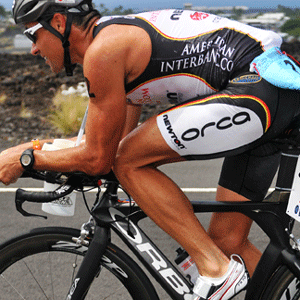Chris Lieto – chasing Kona dreams
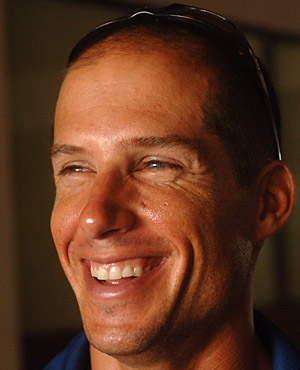
Chris Lieto is one of the very best cyclists in the sport of triathlon and has three Ironman wins in which he set two bike course records. One measure that he is on the verge of triathlon greatness is that he broke Thomas Hellriegel’s 9-year-old bike course record at Penticton while winning in 2005. The other sign that now, at age 36, he might have it in him to move up in class was his brave surge to the lead from Mile 6 to mile 14 in the run at Kona in 2007. When Chris McCormack came up on Lieto’s shoulder, a more prudent man might have let him go. But Lieto, saying later “I am not in this race to make a top five or a top three. I’m in it to win,” stayed on Macca’s flying feet for a long stretch until the inevitable toll of a too hot pace kicked in and he struggled home 6th. Last year, he showed he had serious short course speed by setting a course record at the venerable Columbia Triathlon, where several greats like Matt Reed and Hunter Kemper have taken a cut. While he was primed to advance at Kona, a mysterious virus or possibly vog effects left him off form and walking his way to 28th. Six weeks later, he regrouped and showed his true capabilities with a strong second place finish at Ironman Arizona where his 8:19:25 time was the second best in the race’s history.
The 36-year-old resident of Danville, California, is one of, but not the most famous resident of his home town. Just this month, Lieto was finishing up a long training ride when he had to wind his way around a big parade honoring hero pilot Chesley Sullenberger, the man who safely ditched his faltering US Air flight in the Hudson River with no casualties. Lieto was seeking a spot at the head of his sport's parade. He visited Boulder this week trying to find a few slight but crucial fit improvements with his Trek bike at the Retul office on 55th Street.

A note to Slowtwitch tech experts who pounced upon photos of Normann Stadler at Retul, claiming the German uberbiker had lousy form: The fitting process is a long, gradual examination of many factors and is not a pop quiz of the ultimate perfect bike position. You can trust Lieto to look good, be smart and go fast when he hits the race course.
Slowtwitch: You seem to have more bike shoes here than Imelda Marcos. What are you trying out?
Chris Lieto: I’m trying to decide between the Bontrager and the DMTs.
ST: Is it a fashion issue?
Chris Lieto: No, whichever one functions the best. The new Bontrager shoe is a good shoe. It's real comfortable. Want to make sure it’s the right shoe for me. I've ridden DMT the last four years. They are coming out with new shoes this year. It’s different from the shoes I've always ridden, So I want to make sure whatever I wear fits well.
ST: Have you have bike-related foot problem before?
Chris Lieto: I had my foot run over by a car and had 50 fractures a decade ago. Since then, I've had issues with my feet and ankles.
ST: What have you done to adjust for the foot that was smashed?
Chris Lieto: It’s gotten better over the years. I use orthotics. I also have to cut a hole in this shoe to relieve a pressure point. It's the same thing with running. K-Swiss has come out with some good running shoes this year that have allowed me to run well. I run in the Conejo shoe, which is a really good trainer. I have also tested some prototype shoes that are going to come out.
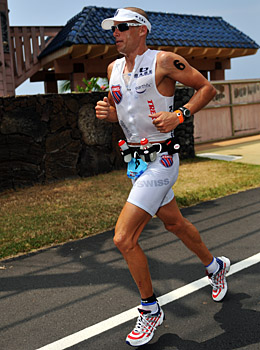
ST: Do you prefer light racing flats, or do you need more support?
Chris Lieto: I need a little more cushion because of my foot. So I have to have some support in there.
ST: Has it continued to flare up the last few years?
Chris Lieto: Yes. But it’s gotten a lot better. But early on, back when I won Ironman Wisconsin (2002) and I got second at Lake Placid (2003), from that whole period prior to winning Ironman Canada in 2005, a lot of my Ironman races went bad because of foot problems. I’d be in the run and in a great position, then all of a sudden I’d get a really bad blister, or pain in the ankle or whatever and that would slow me down. I also have had problems in Hawaii (where he finished 9th in 2006 and 6th in 2007). I had a pain in the ankle this year. That’s not why I had a bad race. But I am always fighting to keep my feet healthy in training.
ST: What did you do to continue racing at a high level and cut out the DNFs? What is most important thing you did to preserve your wheels?
Chris Lieto: I think part of it was time. Healing it up. Getting it tough. Working on core strength. Working on ankle strength. Making sure I am in the right shoe that gives the right support, the right cushion. So trial and error was the biggest piece. Now I know what’s going wrong before it gets bad. So I always have to train in shoes that I race in and make sure that they work really well. Sometimes it's a pain. I can’t just grab a shoe and go run. I have to make sure all my shoes work well. That’s why K-Swiss has been cool in allowing me a lot of say and input in what they are doing and what works with my foot.
In some senses, it’s more of a shoe than most people will need. Not more built up. More nitpicking with the shoe. Lot of people can take a total neutral shoe with no support, one that resembles a slipper, and have no problem running in it. I can’t do that.
ST: The crucial factor in your dreams of a Kona win is improving your run?
Chris Lieto: The most important thing is keeping injury free. I haven’t changed much in my bike or my running as far as the kind of balance of how I train. To a certain extent, I am doing more in running. But I can do more because I’m not getting injured. So it’s allowing me to train throughout the whole year instead of taking two months off because I've hurt something.
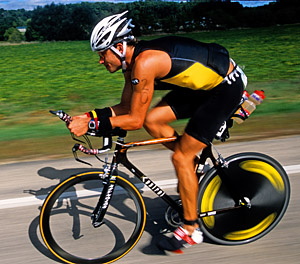
ST: One aspect of your training has been to go on a very tough cycling road race a month or so out from Kona. Does that replace some of the run mileage and help you avoid overuse injuries?
Chris Lieto: No. I think it’s two different things. I enjoy the bike racing because it is fun and breaks up the monotony of training for triathlon. And the rhythms and challenges of a cycling stage race are different. In a road race, you go harder. That’s the only factor that technically should improve fitness going into Kona. In those races, I don’t get to dictate the amount of effort I put out. I am responding to a certain extent. And I am an aggressive rider so I like to try things. Sometimes I ride a lot harder than I should.
ST: Does knowing your redline limits on the bike in cycling races help on the big day in Kona?
Chris Lieto: I think I learn a lot from it. I know I can suffer for a long period of time. But bike racing is different because it’s not consistently hard for four and a half hours. You go as hard as you can for 10 minutes. Or hard as you can for half an hour, or attack again for five minutes. Then it is settling into an Ironman pace and then going hard again.
ST: Are you working on aerodynamics?
Chris Lieto: I focus on the small things. Because the more you focus on them, the more results you’re gonna get. It adds up. So yeah, I've been in the wind tunnel a bunch with Trek and we have dialed in some stuff. One of the things I’ve learned is that a lower position, or slamming your position, is not always better aerodynamically and for ultimate energy efficiency on the run. Sometimes it is — and sometimes it's not worth it. That’s why I’m here at Retul, to get a position that’s going to dial me in to the most efficient power output with minimal drag.
ST: Which is more important?
Chris Lieto: Drag takes a second seat to the fit. We look at drag and we consider it, because it’s valuable and very important. But if I can produce more power with a little bit more drag, the end result is going to be a faster time. And that’s what I want. It's also in service to the fact that I have to get off the bike and run. So it's not all about pure aerodynamics.
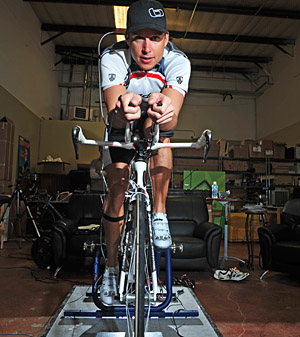
ST: What are you looking for here?
Chris Lieto: I want to look at a position to maximize my power output.
ST: Can you guess what your small problems are?
Chris Lieto: I don’t know. That’s why I’m here. To look at those small things. I think I was in a decent position. I don’t know if I need a lot of change. I’m checking out my Q factor, my hip width, to make sure my angle’s right as far as fatigue in an Ironman. I think that affects me a little bit in the hips and the glutes. If my saddle is off by 5 mils, is that gonna tire out my hips a little more than some other position? That’s what we’re gonna find out today and see if we can improve on it.
ST: Some triathletes ride with a flat back. Others have a slightly rounded back. Some have a radically low position, folded up like a jackknife. Some, like Crowie, sit up a lot more. How would you describe your position?
Chris Lieto: Visually it looks pretty good. I know it works well. But I am not the expert. That’s why I’m here to work on my bike. But more so I’m here to work on my run after the bike. To use as much power and as much speed on the bike, but allow me to have more strength for the run. That’s what I’m after, something that fits the style of racing that I do.
ST: What is that style?
Chris Lieto: I like to ride hard. I like to be off the front. If I can still do that and have more left afterwards, that’s what I’m after. That’s my goal.
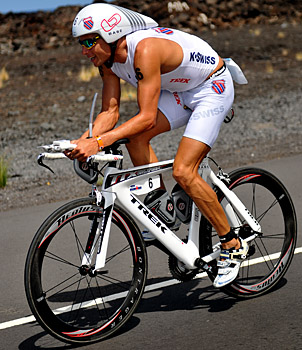
ST: What do you think happened to you in Kona in 2008?
Chris Lieto: It’s interesting. Why was my performance not there in Kona? I still had a decent bike ride. But I was suffering to hold the wattage I normally make with ease on a training ride. With a lot of people having bad days, was it something going around? I had a cold about 10 days before. Had some sort of viral thing that lasted a few days. I don’t know where it came from. Coulda been the vog, there are lot of variations of what could have happened. But the fact is that many other people felt the same on the bike. Could it have been the vog? Could it have been a cold or the flu going on outside? I had a viral thing a week and half out.
ST: How long did it take to recover from the viral infection?
Chris Lieto: You don’t know. It was small but if I’m down 2-3 percent in an Ironman, it’s gonna be huge. I was fitter than I've been. I was ready to race. Did I lose the balance between being really fit and getting enough recovery?
ST: Looked like you were going according to plan and started the run hard.
Chris Lieto: On the bike from the get-go, I didn’t have the legs that I normally have. So it may have looked I was according to plan. But I was forcing my power to stay within range. Reading my wattage meter, I thought ‘OK, this is where I am supposed to be.’ I had to keep within that range to stay in contention. So, were my legs feeling bad the first half hour? Would they start feeling better as I was going on? I didn’t know what was going to happen. Sometimes you don’t feel good on the bike and you feel good running. So I stuck to the plan on the bike even though it felt like a lot more effort. But when I got off the bike I could tell right away I didn’t feel good. I tried to push through and suffer through for the first 10 miles and it just killed me. At Ironman, especially in Hawaii, those who don’t give in or give up are the ones who have good races. But there is a distinction between giving up mentally and surrendering physically. At that point, I could not go any more.
ST: Were you still questioning yourself after the race?
Chris Lieto: After you finish you always go, ‘Was it completely physical or was there an aspect of the mental?’ I believe it was all physical. So I am going to adjust my training a little bit.
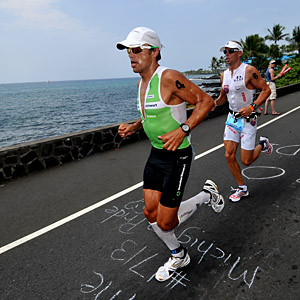
ST: How did you recover well enough to race decently in Arizona six weeks later? In fact, both you and Andreas Raelert broke Michael Lovato’s 2006 course record, and bested times set by the likes of Faris Al-Sultan, Rutger Beke and Tim DeBoom.
Chris Lieto: Overall, I have come to believe that rest and recovery are most important. They are key. The training was secondary. But, for a good reason, you can carry fitness through and fake it a little bit. I wasn’t primed for that race, I wasn’t keyed up, I wasn’t focusing on it. But I had a lot of fitness I didn’t get to use at Kona. In Hawaii, I still finished the race. But I walked and jogged a fair bit. So I didn’t get a chance to showcase my race fitness to see where I was at. Arizona was a little bit of a test it to try some new things, but also to qualify and get that out of the way. I wanted to try to get a win. But little did I know that Raelert was going to show up at the last minute.
ST: Once you decided to double down and race two Ironmans in six weeks, the pressure was on at Arizona.
Chris Lieto: The thought of trying to put in that amount of time and focus and mental preparation for that race and not get the result I wanted was hard for me to imagine. The amount of dedication and sacrifice needed to do well at an Ironman takes a lot out of you. I didn’t see myself doing Australia or New Zealand at another early season race in 2009. I got family and I like to be at home.
ST: How did Arizona feel?
Chris Lieto: I was fresh and I was rested. I had some power, but I tried to hold back on the bike and just ride a little bit easier and just try some new things. The longest training ride I had was an hour and a half. So I was fresh and I felt good in the first parts,. The first part of the bike I felt great. It seemed super easy. The second half I felt a little tired. The first half of the marathon was easy. Flying. Piece of cake. Then the second half I started slowing down and the last six miles I suffered because I hadn’t done any endurance training. But I got the job done. I qualified for Hawaii.
ST: What did you think of Andreas Raelert, who beat you at of Ironman Arizona?
On the swim, Raelert’s 46 minutes led Lieto by two minutes. Lieto and Slowtwitch’s Jordan Rapp then outrode Raelert 4:26 to 4:37 for a 9-minute lead. Raelert then ran 2:46 for the win while Lieto ran a 3:00:12 marathon to hang on for second place by 20 seconds over Rapp.
Chris Lieto: I knew Raelert was going to be a guy to watch out for on the run. I knew he was not going to be a factor until the last 5-10 miles of the run. After his run-from-behind second place at Clearwater, plus what he did in to win at Monaco 70.3, it’s clear he is a phenomenal runner. And it was his first Ironman. Usually you can run your best your first time out.
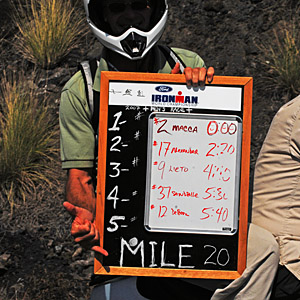
ST: What was your best Ironman bike to your standards?
Chris Lieto: At Ironman Canada in 2005, I broke Hellriegel’s bike record. I wasn’t running much prior to that, so I was doing a lot of riding so I was bike fit.
ST: Hellriegel’s bike mark lasted a long time.
Chris Lieto: Yeah It lasted nine years. It was a good day but I also felt really good on the bike. I was chasing Lessing the whole time. And so I pushed it. The conditions were good. You know Hellriegel set an overall record because he followed that bike with a phenomenal run. I set a new bike record, but paid for it on the run. I still got the win, but I suffered.
ST: How can you combine a bike like that with your best run?
Chris Lieto: Yeah, that is why we are approaching things a little bit differently this year in my training and racing. Historically, I race from the gut and I’m always racing hard from the get-go. So sometimes I pay for it and it affects my run. Sometimes it doesn’t. And I so it's a crap shoot. In Ironman racing, you put everything on one day. And it could be the wrong day. But I’m always going to put it out there to race my best. Sometimes it’s a perfect day and it pans out. Sometimes it's not, and I suffer a bit.
ST: Do you think about the bike course record in Hawaii?
Chris Lieto: That's not what I think about. It’s about being in a position to try to win. If that means being first off the bike on that day, that's it. But I don’t think about course records apart from my overall goals.
ST: Even a tiny bit of regret for going so hard on the run at Ironman Hawaii in 2007 and dropping back from the podium to 6th place?
Chris Lieto: I don’t think I went that hard on the run. I think the run pace I was on was good. When Macca caught me (at mile 13) and I ran with him, did that possibly cost me a top three finish?
ST: Maybe.
Chris Lieto: Possibly, but I don’t know. I was trying to go for a win. If I didn’t try to run with him, then I would always wonder. So I don’t regret how I raced that day and how it turned out. Of course I would have loved to have gotten a top three instead of sixth place,. But that is the way I race every race. I believe that’s the only way I was going to learn and expand and get better. My goal is to win Hawaii, – not to get top 5 or top 10. Sometimes I get it right. And sometimes, like this year, I fall apart and I was 20-something.
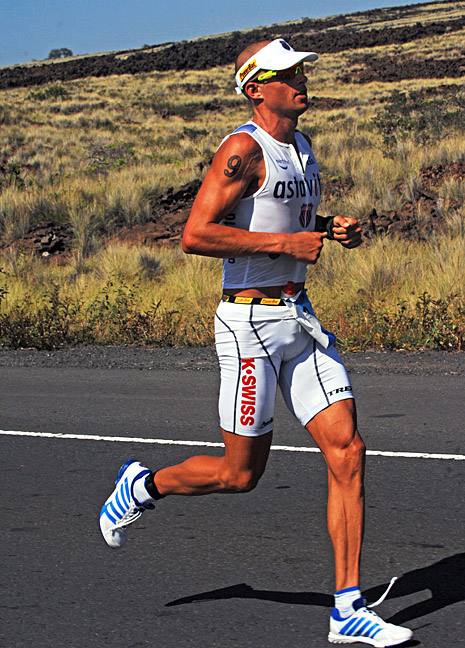
ST: What is your best competitive distance?
Chris Lieto: I don’t know. I love to race. So I love sprint distances. And I excel at those.
ST: You got a course record at Columbia, Maryland last year. A lot of excellent short course triathletes raced there in the past.
Chris Lieto: I like Olympic distance races because you can race more often and I love to race. So this year I will work more on the shorter races, focus on my run speed and see if I can transfer it to the marathon. I think it will help that I don’t have to do an Ironman before Hawaii
ST: What was the reason for switching coaches from Lance Watson to Matt Dixon?
Chris Lieto: Just a difference in style. One, Matt is a local so I get to see him a fair bit and he can check out what I’m doing and how I’m doing. We go on rides and stuff like that. So I get a little closer monitoring. And also I am a believer that the key to performance enhancement starts with recovery. And that aligns with my sponsor, BASE Performance Nutrition. It’s a located in Alamo California, which is next to Danville. We focus on foundational health from the ground up. I also plan to I get more rest. A lot of athletes train too much. This year I will probably train a little less and drop my volume down 10-15 percent, if not more, and ramp up the intensity in specific spots.
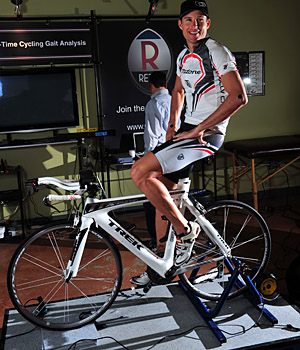
ST: What will it be like when Lance hits the Queen K?
Chris Lieto: Lance who?
ST: Exactly!
Chris Lieto: I think it will be great for the sport. It will be fun. Hopefully with us both being on Treks there will be some synergy there. I’d love to give him some advice,. I don’t know how much advice I could give him besides just the experience of doing it. He is phenomenal athlete and I think he will do great. He will be one to watch out for. Anything he does he excels at. So, I’ll be exciting and I’d love to …
>b>ST: Beat him?
Chris Lieto: Of course I’d love to beat him. But also to be a part of what he’s doing. If that is through trek or Bontrager or LiveStrong, whatever. It would be great to be a part of that and see it happen.
ST: What would you imagine his race would be like?
Chris Lieto: Probably come out of the water 5 minutes back, if not a little more. He probably would have a race like Steve Larsen in 2001.
ST: Larsen swam 1:00:45 then passed everyone to lead off the bike. But Lance used to be a fast swimmer as a teenager.
Chris Lieto: He’ll still come late out of the water so he’d have time to make up. Then he’d pass everybody and get off the bike first. What happens next depends on how much running he puts in.
ST: Are you guessing he’ll be five minutes up?
Chris Lieto: On me? Or the pack? On me, I’d say a minute. CHUCKLES. Just kidding. I have no idea. It's hard to measure that. It could be five minutes, it could be a little more. My fantasy guess would be he that would come out of the water behind and he would catch me and then we would ride together off the front and get off the bike together. Then he would get tired and drop and I would end up winning the race. CHUCKLES.
ST: But what would you bet?
Chris Lieto: He would have lead on the bike and he would try to run the best he can. The final result would depend on his preparation. I don’t think he will win.
ST: What would he run? He did a 2:47 straight marathon.
Chris Lieto: Three oh five maybe.
ST: Which would put him?
Chris Lieto: Top ten probably. He could do better. It's hard to say. You just don’t know. It depends on what his goals are and what of preparation he puts into it. Does he want to participate and do something for LiveStrong? Or does he want to try to win? If he is going into the race to win, then he will prepare to win. And then the result will be different because he will try a lot harder. If it is just to participate and do something for LiveStrong, he won’t have that weight on his shoulders and he will probably finish top 10 or something like that.
ST: Do you have thoughts about the rumors that Peter Reid will come back?
Chris Lieto: I have heard them. But I don’t think he will. I think he is smarter than that.
Below is a video of Chris Lieto getting fitted.


